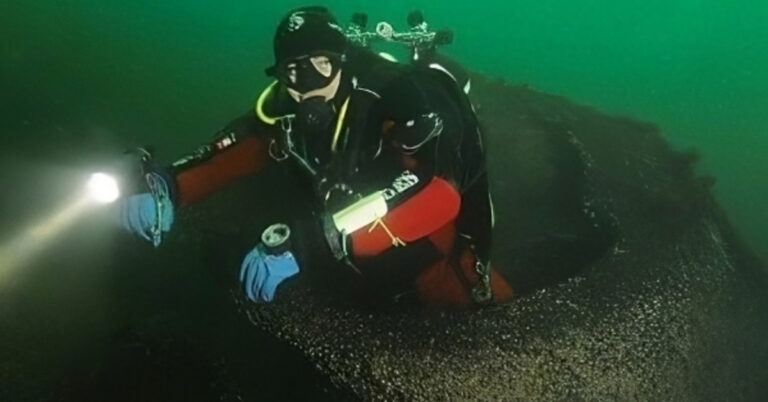
The Schleswig Holstein sailed into a harbour near Gdansk on an apparent courtesy visit, only then to fire on the Polish garrison. These, as it turned out, were the opening shots of WW2. Marcin Trzcinski dives an historic battleship wreck.
0447: Open fire!
0448-0455: Eight 280mm heavy artillery shells and fifty-nine 150mm light artillery shells hit the south-western section of the Westerplatte wall – not to mention 600 rounds from C30 machine-guns.
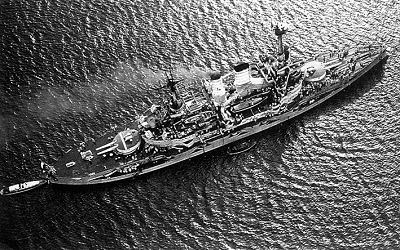
The battleship approaches the target with her bow directed slightly against the slope of the docks, the tug Danzig at her stern. Numerous harbour buildings are hit and set ablaze.
0455: Suddenly two or three breaches in the wall can be seen. Hold fire! Red rockets!
0456: The assault company commences its attack. Soon explosions can be heard from the right wing, where the railway gate has been destroyed.
Machine-gun fire is heard from Westerplatte, some rounds passing over the battleship's bridge.
SO THE VERY BEGINNING OF WORLD WAR TWO is described in the combat log of the battleship Schleswig-Holstein. It was the defining moment in the vessel's long history.
However, her story began 35 years earlier, on 11 June, 1904, when the Imperial German Navy placed an order for a new Deutschland-class ship with the Krupp shipyard in Kiel.
On 17 December, 1906, Germany's highest echelons were present for the launch, including the Emperor Wilhelm II and his wife Augusta Victoria; Alfred von Tirpitz; Alfred Krupp and many others.
The Empress (born Schleswig-Holstein-Sonderburg-Augustenberg) crashed a bottle of champagne into the side of the new battleship, naming her Schleswig-Holstein.
The initial years of service were filled with manoeuvres, visits and inspections. By the time war broke out in 1914, the battleship was already technically obsolete.
However, she was stationed in the Baltic with Vice Admiral Scheer's 2nd Squadron and, on 30 July, three days before the war began, was deployed to Wilhelmshaven.
Two years later, Schleswig-Holstein would take part in the war's biggest battleship confrontation, the Battle of Jutland.
On the evening of 31 May, 1916, the line-ship New Zealand spotted the silhouettes of 2nd Squadron battleships and opened fire.
Schleswig-Holstein was hit as she tried to defend herself (a gun chamber was shattered), but she turned and disappeared into the smoke and gathering darkness.
By 2 the next morning, she was back in the battle. “We noticed again the enemy battleships, both from the bow and the port board,” recalled the British Commander Stirling, in charge of the 12th Flotilla of destroyers, as quoted in Zbigniew Flisowski's The Battle Of Jutland. “We immediately increased our speed to 25 knots and changed course to attack from the angle of 45°. It was clear that the Germans had not noticed us…
“Almost at the same time that the Faulknor fired her second torpedo, the Germans noticed our flotilla and all their battleships opened fire. The distance between us must have been less than 1400m, and many missiles flew over our heads.”
The German battleship Pommern was sunk, but many British units suffered severe damage.
THAT WAS THE END OF SCHLESWIG-HOLSTEIN'S WW1 fighting history. The ship was old enough to escape the fate of other German units, and was not scuttled at Scapa Flow.
In 1921, she even became the flag unit of the Reichsmarine. Reconstructed in 1925-26, she went on to be a teaching ship, carrying Imperial Navy cadets to South America and Africa.
And in 1939, Schleswig-Holstein found her place in history when, on 25 August, she moored in New Harbour in Gdansk, just opposite Westerplatte.
The German battleship had arrived apparently on a courtesy visit, but then fired the opening shots of the war on the Polish garrison.
The resulting Battle of Westerplatte lasted seven days.
The battleship took part in further actions off the Polish coast and, on 27 September, was hit from a land battery, again in a gun chamber.
In April 1940, she participated in the assault on Denmark, including getting stranded in the shallows.
Subsequent years were filled with restoration work and training cruises from Gdynia, Poland.
On 18 December, 1944, the battleship took three hits from RAF heavy bombers in an air raid, and sank to the bottom of the harbour basin.
On 25 January, 1945, Schleswig-Holstein was removed from the Kriegsmarine's inventory, though two months later withdrawing Wehrmacht units detonated explosives aboard the ship.
This failed to stop the Russians raising her in 1947 and towing her to Tallinn harbour, where she served initially as a warehouse.
Finally, in the late '40s, she was towed into the shallows near the island of Osmussar, to be used as a target for Russian artillery and the air force.
Even in the 1970s, the remains of the battleship were visible above the surface.
Schleswig-Holstein achieved no particular successes, yet she became the symbol of the beginning of the bloodiest conflict in the world's history.
So when I was offered the post of photographer on an expedition to dive the wreck, I didn't hesitate.
This challenge was interesting from a technical point of view, but also had a very emotional side for me as a Pole, well aware of the heroic defence of the Polish outpost at Westerplatte.
LAST SEPTEMBER OUR EXPERIENCED GROUP of divers, armed with all the relevant paperwork from the Estonian authorities, departed from Hel harbour (near Gdansk in Poland) aboard a former Danish cutter turned diving unit called Nitrox provided by Globe Diving, and supported by the Navy Academy.
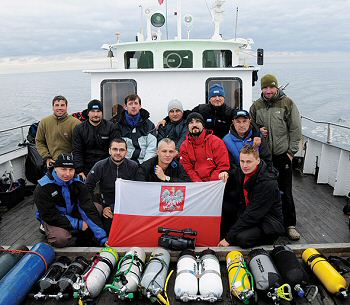
Our destination, off Estonia, was almost 400 miles away. We had chosen September because good weather and visibility were predicted (and because, near the end of the Polish diving season, the charter was more affordable).
But the Baltic Sea is unpredictable. A storm forced the captain, after 12 hours of fighting waves, back to harbour.
Our second attempt went better, but tough conditions again rendered the trip very difficult, prolonging it by 24 hours.
At last we saw the tiny harbour of Dirchami on the horizon, and the weather-beaten crew were able to savour the safety of the land. We had a brief moment of relaxation before we dived.
Inching my way along the bench towards the gangway, I watched my colleagues take turns to jump into the sea. Eventually Alek and Marek disappeared overboard, and I could make my way to the gangway.
The moment I hit the water, I felt the current grab me and drag me towards the stern.
So I would have to fight the elements too – not a great prospect, with my hands full of camera.
Metre by metre, I struggled towards the bow, moving both hands along the line suspended beside the cutter.
Where the line ended, I started my descent along the anchor-chain, but progress was no easier submerged – the current was as strong as the wind above it. The wreck lies in just 10m, yet the next couple of days would not be easy.
Finally, I saw the bottom. It was smooth and rocky, and there was a rusted missile on it. It was intriguing, but it looked too new to have come from Schleswig-Holstein. It was probably an unexploded Russian shell.

I struggled along the descent line, fixed earlier by Marek and Romek. Fragments of the gigantic ship started to loom out of the darkness.
They did not look as dangerous as on the photos from the assault on Westerplatte, but it was undoubtedly Schleswig-Holstein, sides furrowed by the shells of the Soviet artillery and, earlier, by British bombs and Nazi mines.
WE STARTED IN THE STERN SECTION, which rose high towards the surface. Not far from there was the ammunition warehouse, where 280mm shells, lying in rows and layers, had been turned into a single entity by hundreds of crustacean shells – as had the ship itself.
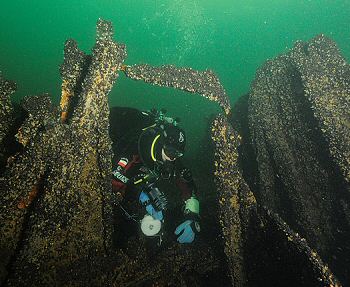
The middle section, with its twisted and torn metal, looked far worse. At times it was impossible to recognise anything but, penetrating fragments of the wreck and discovering more characteristic elements of its structure, we kept moving forward.
Every now and then one of the guys would flicker his torch, summoning me to record yet another finding.
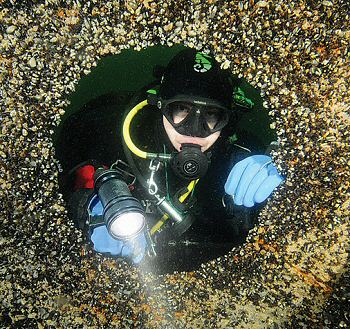
However, it was only on the second dive (and I had solemnly promised myself that I would not enter the water if the strong current persisted!) that we located the huge gear that had formed the basis of the bow artillery turret, with its two 280mm guns.

It was a pity that the guns could not be found, but the view was impressive. Romek and Marek started to measure the turret and I was able, with difficulty because of the current, to take photos.
We moved on, passing over the wooden deck, boards still in surprisingly good condition, and some electrical cables to reach a pipe that we assumed to be the funnel. Was it really that? None of us had the strength to make further measurements.
Instead, we let the current carry us towards the bow to search for one of the anchors. A hold found by Radek proved to contain the huge anchor-chain, though the anchor was missing.
Our disappointment was diminished by other findings on the way back – a bulls-eye (similar to a dead-eye), and a fragment of a machine telegraph. The wreck was full of many such small but interesting elements.
We spent the following evening in Dirchami harbour, swapping notes.
A more detailed picture of the wreck took shape as we placed identified elements on the sounding images. Using the photos, we could establish with some precision what was located where.
Finally, pots with soup made from fermented rye flour along with pork chops and potatoes appeared on the mess table. The Schleswig-Holstein plans disappeared in seconds, and discussion gave way to the tinkle of cutlery.
Plans for our next dives formed. We needed more detailed measurement of the bow gun turret, another look into the darkness of the ammunition warehouse and a peek into the interior of the wreck in the mid-section.
We distributed tasks. It was piercingly cold outside and the dark, low clouds boded poorly for the busy day ahead.
I went down the narrow stairs and squeezed into a bunk. Elements of the huge, devastated mass of steel that had left such a huge imprint on the fabric of history remained imprinted before my eyes as I dropped off to sleep.
THE NEXT DIVE required as much effort as the last, because, although we were able to move more confidently over the wreck now that we understood its layout better, the current seemed if anything to have increased.
I started with the elements pointed out to me by the guys the previous day – the huge grate structures at the stern, the lower deck in the middle section, the propeller-shafts and so on.
Many elements remained a mystery; identification would require very detailed measurements and lots of work involving the construction plans of the battleship. Take the huge triangle with an opening in the middle, located in the middle section on the port board. What was it? What was its purpose? Such questions multiplied over time.
We had gathered documentation. Now we were taking photos, filming and measuring. The time for categorising data would come later.
Just before returning to the surface, I took the last photos and they were symbolic – a white and red Polish flag flapping in the current over the remains of the Nazi aggressor.
